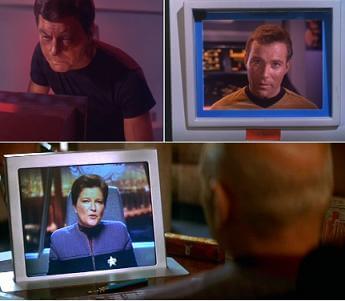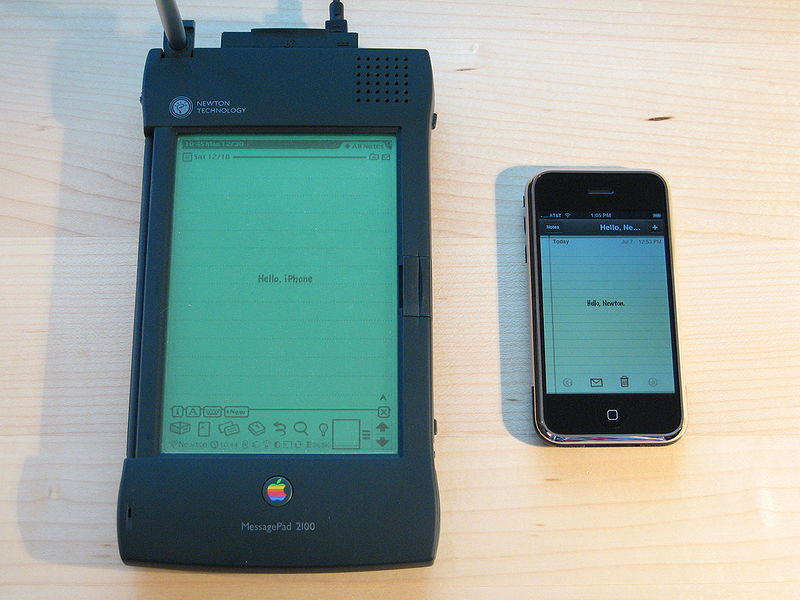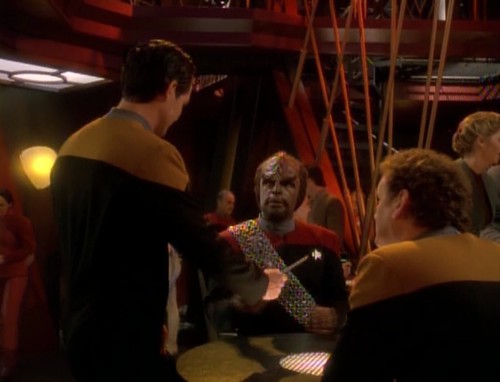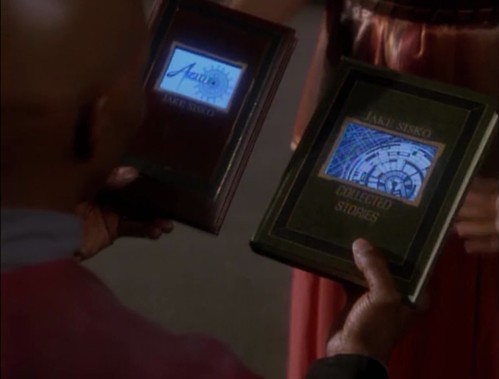“A good science fiction story should be able to predict not the automobile but the traffic jam” – Fredrik Pohl
I’ve been watching Star Trek: Deep Space Nine recently for the first time in 20 years. I have vague memories of the pilot from its original airing when I was in middle school, mostly of marveling at its digital effects, which were shocking to see on TV in that era. This time around, however, what hit me was something different: the characters on the show are constantly handing each other iPads.
Here’s a characteristic example, some anonymous yellow shirt giving Worf a report:
The iPads seem to be the method of choice for delivering reports, important documents, and programs.
In another episode, Little Green Men, O’Brien and Bashir give a young Ferengi heading off to Star Fleet Academy a gift: “It’s not just a guidebook! It’s a completely interactive program detailing Earth’s customs, culture, history, geography.”
And this iPad-handing wasn’t just a DS9 phenomenon. It happened across the entire Star Trek franchise at that time. Here’s an example from the 1996 movie Star Trek: First Contact. The overworked Picard’s desk is overflowing with them.

After doing some research, I learned that in the Star Trek universe, these things are called PADDs for Personal Access Display Device. And they’ve actually been around since the original series episode The Man Trap.

Obviously, PADDs are physically very similar to iPads. At first, they seem like another example of Star Trek’s track record as a predictor of futuristic devices. The most famous example of this is the communicators from the original series, which Martin Cooper, inventor of the mobile phone, cited as an inspiration.

But, as I watched the PADDs circulate around the show, I slowly realize that they’re not actually used like iPads at all. In fact, they’re more like fancy pieces of paper. Individual PADDs correspond to specific documents like the Earth guidebook shown above. To give someone a document, people carry PADDs around and then leave them with the new owner of the document.
Further, the existence of PADDs and incredibly powerful computers seems to have in no way transformed the way citizens of the 24th century consume or distribute culture. A Deep Space Nine episode, The Visitor, centers on Jake Sisko’s career as an author. Here’s what his books look like:
If the books are digital documents with digital covers, why do they each have their own piece of hardware? Why don’t individual PADDs store millions of books?
Further, much of the plot of the episode turns on Jake’s success getting published. The publishing industry of the late 24th century seems in no way disrupted or altered by the existence of digital technologies.
From a 2013 point of view, these uses seem completely inside out. Each PADD is bound to an individual document rather than a person or location. This is a universe where its easier to copy physical objects (in a replicator) than digital ones.
After thinking about this a bit I realized the problem: they don’t have the Internet!
During the run of The Next Generation (1987–1994) and Deep Space Nine (1993–1998), the Internet wasn’t part of most people’s lives. The Next Generation averaged 9 or 10 million viewers per season or about 3 times the total number of US Internet users at the time (1.2% of the US population had Internet access in 1991) Hotmail launched on July 4, 1996, two years after The Next Generation went off the air. Google launched in 1998, as Deep Space Nine was winding down. Email, search, and the web itself were only starting to be part of large numbers of peoples lives by the late 90s as DS9 spiraled towards cancellation.
Obviously, the Internet existed before this time and I’d bet a disproportionate number of the writers of TNG and DS9 were on it. But the usage patterns that have emerged with culture-wide adoption weren’t in place yet. And they clearly wen unimagined by Star Trek’s creative team.
The entire communications model on these shows is based on phone calls and radio. Everything is realtime. They have subspace communications, which is basically faster-than-light radio transmission.

Even those vaunted communicators are basically just fancy CB radios. You have to have a live connection to the other side or you can’t send a message, a device used constantly int the plots of individual episodes.
They use live video chat regularly (as the original series did), presumably over subspace.

But they don’t seem to have any forms of remote asynchronous communication or collaboration. They don’t use text messages. Scientists are constantly physically visiting various facilities in order to access their data.
Unlike “subspace communications”, the Internet is not a technique for transmitting information through space, it’s a scheme for organizing its transmission, regardless of medium. As Cory Docotorow has said, the Internet is a “machine for copying”. That’s why the prevalence of these PADDs seems so absurd to a modern eye. In any future that includes the Internet, digital documents will always be more ubiquitous than the physical devices for displaying them. If you have the ability to send the data required to replicate a new PADD to display your document, how much easier must it inevitably be to just send the document where it needed to go in the first place?
In fact, iPads are feasible and desirable exactly because of the patterns of information transmission created by the Internet. We chiefly use them to consume downloaded media, to read from and post to communication networks like Twitter and Facebook, to send and receive email, to browse the web. Without net access, an iPad would be a Newton, a technology whose lifespan coincidentally corresponds almost exactly with the run of TNG and DS9.

Star Trek may have imagined the physical form of the iPad, but they didn’t imagine such a form’s dependence on the much larger and more meaningful change represented by the Internet. Hence, their portrayal of tablet computing ends up looking chiefly decorative in just the way of a lot of science fiction design, reading as “space paper” and “space books” rather than anything truly new.
This brings me back to the topic of my recent post on Thingpunk. The real mistake here, again, is believing that the physical shape of technology is always the futuristic bit, that by predicting the form of devices Star Trek had captured something important about the future. Instead, even in the absence of transporters and replicators, the invisible network that gets those reports and interactive guidebooks onto our PADDs has re-arranged our society in a thousand ways that Star Trek never imagined.




My Newton had three web browsers on it! One was pretty good, too, mostly limited by the network speed.
Don’t you think this is not only a paradigm problem, but a Paramount problem? To this day, big media conglomerates want to anchor bits to atoms. What is revolutionary in the Star Trek universe is the replicator – 3D printing’s apotheosis. Atoms are essentially bits in Star Trek’s world because it is so easy to copy things. Maybe by the 23rd century, our obsession with virtuality and the digital will be seen as a product of our Internet blinders – we can only imagine ubiquitous copying of data, not (like those prescient Star Trek folks) physical objects.
Anyway, the rebooted Battlestar Galactica showed us what happens if you let the Internet onto your starship. It’s not pretty.
Well, I think both the replicator and the transporter are pretty good. But I’m always frustrated with how un-creatively they use both of them. Why even bother having giant starships full of thousands of people that are constantly getting blown up? Why not just send out a relay network of long distance autonomous satellites and then beam through them when you want to end up somewhere.
And same thing with replicators. Every third DS9 episode is about some kind of intrigue with cargo or the cargo holds. Why are they physically carting around so much stuff instead of replicating it? Is it really harder to replicate “gold-pressed latinum” than complex food stuffs that have the right chemical composition to get various races drunk?
The replicators and transporters seem to have replaced certain kinds of human labor without actually altering the structure of society or culture much.
I definitely agree that a lot of this is to tell a better story. DS9 might be better sci-fi if it was utterly alien, but it would be probably significantly worse drama.
Nice theory, but…
I remember watching The Next Generation when it first aired. Captain Picard was handed a crew report on a PADD. Perhaps I was ahead of my time, but I remember thinking “why didn’t he just pull it up on his own PADD?”
So the technology certainly was already within reach, even back in the 80’s.
Then I realized: it doesn’t make good storytelling. The viewer doesn’t want to see Picard searching for a file or syncing his PADD with somebody else. That isn’t what a starship captain does. He is handed reports, takes important decisions and gives commands, which his crew dutifully execute. That’s what the story is about.
The same goes for async communications. Reports often “come in” to the bridge from sickbay or engineering or “all decks”. The audience doesn’t care about the message, or the medium, but about the characters and the plot. When it makes sense for the story, the characters are shown in real time (“video chat”) and can talk. When it doesn’t, reports “come in”.
And as for the internet: it certainly did exist. We just didn’t call it that yet. We called it Usenet, uucp, FidoNet etc, depending on your particular flavor.
You’re definitely right that there’s a storytelling bias behind this choice. That’s a good point.
But I think you could say the same thing for the cliched “NOW HACKING PENTAGON” progress bars and other nonsense that used to make up computer UIs in movies. Those were there because the filmmakers were afraid that the audience wouldn’t be able to follow the storytelling points happening through the computer UI. We’ve only just reached a point where everyone is so familiar with computers that those kinds of shortcuts have become embarrassingly comical (I’d date the moment change to David Fincher’s The Social Network, but you could probably pick other points).
And I think we’ve reached a similar point with Internet usage. Obviously the Internet was around during the 80s and 90s when TNG and DS9 were airing. As I mentioned in the post, I’ll bet the writers of Star Trek were right there with you as early adopters using i. However, it’s now reached a point of ubiquity and comfort for the viewing audience that the lack of it on these shows is starting to seem like a historical artifact of the time of the shows’ creation. The idea of starship captains in the 24th century operating in a way that looks more like mid-century
generals or businessmen is getting increasingly bizarre as the 21st century marches on.
Who needs the Internet for data storage when they have “Data”? And didn’t Dick Tracy have a wristwatch T.V. / phone long before the communicator? but didn’t Uhura work with a blue tooth earpiece?
I’m pretty sure the “now hacking pentagon” graphics were purely ignorance of the movie makers as well as the general public at the time.
But sometimes cheesy works well to set the scene. How many movies and shows today still use “teletype” in the lower third to indicate a location or date? Usually with equally cheesy digital bleeps. Unrealistic, but it works. It preps the audience for something techy to come.
…something that Star Trek never used, by the way. They had the “captains log, supplemental” for that purpose.
I guess i will say it first……..but the iPad was NOT the first tablet. Microsoft and Intel created the first tablets back in 1999-2001. iPad was popularized as the industry grew at least 6 years later. They had been working on it for quite some time, but they were certainly not even close to being inspired by Star Trek. Intel and Microsoft were inspired and then Apple had to try and one up them and make their own. Same goes for today with Apple TV and the Xbox One. Please do a little more analysis into what you are talking about before you spout a very incomplete story.
The first tablets were not created by Microsoft and Intel; they were created by ancient civilizations. Tablet technology was a critical step in the transition from oral to written culture. If we look at the larger function of tablets historically they were used to write and communicate data temporarily. In this regard, the permanence of Star Trek tablets definitely comes off as unusual, regardless of the lack of internet.
With the internet, the temporary nature of the tablet’s historical use case returns, but with a twist. The internet enables one tablet computer to be used for multiple different things simultaneously. This introduces a new variable into the dynamics of tablet user experience: distraction.
What we could be asking ourselves is: why didn’t Star Trek predict the fact that people in the future would be losing the ability to maintain eye contact, carry on deep conversations and generally be in the present moment?
Perhaps the bizarrely antiquarian analog quality of the tablet technology in Star Trek is a cautionary tale. Ever notice how intense some of the passages of dialogue are on Star Trek? Long stretches of emotive exchanges, with generous pauses underpinned by the hum of the space ship. This isn’t just good drama or storytelling, it may also be a good archetype for genuine human interaction at times.
Full disclosure: my company is currently developing a new whiteboard tablet technology. This article jumped out at me because just yesterday we released this teaser video, A Brief History of the Tablet: https://vimeo.com/98473277